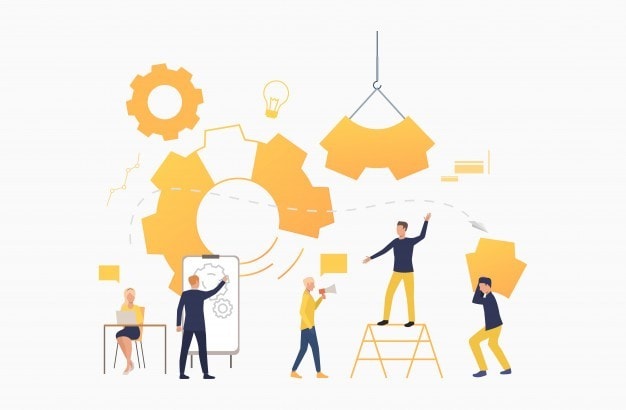
What is Organisational Design? Types, Methodology, and Principles

Organisational Design refers to the process of designing and identifying the structure of an organisation It involves determining the chain of command, formalisation, departmentalisation, span of control, centralisation, decentralisation, and work specialisation There are traditional and contemporary designs, and fundamental principles such as self-reflection, having the right framework, utilising top talent, and encouraging accountability
Definition of Organisational Design
The process of Organisational Design entails the identification and creation of an effective organizational structure. It is a crucial undertaking that enables companies to incorporate innovative and contemporary elements, respond to changes, promote adaptability, and foster collaboration.
The Organisational Design encompasses the strategies and methods employed by a business to effectively balance integration and differentiation of operations, in order to navigate the uncertainties presented by its external environment.
Meaning of Organisational Design
Organisational Design involves developing structures, processes, and roles that enable an organization to achieve its goals and objectives. This includes determining reporting lines and positions on the organizational chart. The goal of Organisational Design is to identify any dysfunctional aspects, realign them to current goals, and create a plan to implement necessary changes.
The methodology of Organisational Design
Achieving increased efficiency, productivity, and profitability is the main objective of organizational design. It is a comprehensive approach that involves multiple steps. The methodology of organizational design is designed to optimize the structure and processes of an organization to achieve the desired outcomes.
Establish a clear design process by drafting a charter that outlines the desired outcomes, resource allocation, participation, deadlines, and communication strategies for your designing initiative. This will ensure that everyone on the team is on the same page and able to work together efficiently.
Before diving into the design process, it's important to assess the current state of your business. This includes understanding its strengths, functions, principles, weaknesses, and whether they align with your core objectives, ideology, and strategy. This assessment will provide valuable clarity about the overall business and help identify areas for improvement.
Streamline the core processes in business that will lead to deliverables to consumers
Documenting procedures
Standardizing procedures
Organising human resources around core processes
Defining skills, functions, and tasks
Defining the performance metrics for each team and making them accountable for their actions
Assessing the equipment and technology requirements for each department is a critical step in ensuring the smooth running of an organization. It involves identifying the necessary tools and resources needed by each team and determining their optimal placement within the workplace. Additionally, finding the right support staff and locating them in the most suitable areas is equally important for the efficient functioning of the organization.
Defining the structure that provides operational support
Improving development systems like goal-setting, sharing of information, compensation, training and hiring, etc
A well-planned and executed organizational design can lead to a harmonious alignment of goals and objectives, while a poorly designed one can result in ineffective decision-making, a lack of trust, and a rigid work environment. To gain a competitive advantage in the industry, it is crucial to focus on the key elements of organizational design. These key elements will be discussed in detail below.
1. Line/chain of command
In a hierarchical organization, the chain of command flows from the top management down to the lower levels. This means that instructions and decisions are made by the higher-ups and are implemented by those below them. At each level, accountability is expected to flow upwards, with each level being responsible and answerable to the level above them.
The chain of command is clarified, and everyone knows to whom he should report.
Advantages of the line/chain of command are
- Clear instructions
- Conflict resolution
- Close monitoring of employee performance
- Increase in productivity and efficiency
- Boost in profitability
- The disadvantages of the line/chain of command are
- Increase in office politics because of power centralization
- Fewer initiatives
- Too much dependency on higher authorities
- Less sense of belonging
- Delay in taking decisions
- Rigid control hence lack flexibility
- The advantages of the formalization are
- Smooth flow of authority
- Boost efficiency
- Less ambiguity
- The disadvantages of the formalization are
- Formal and rigid relations
- Reduction in employee morale
- Lengthy process in decision-making
3. Departmentalization
It is the element of organizational design that deals in dividing the functions as per the responsibility of the job. The common forms of departmentalization are
- Product departmentalization
- Process departmentalization
- Customer departmentalization
- Advantages of the departmentalization are
- Better coordination
- Better control
- Flexibility
- Motivated workforce
- Boost efficiency
- The disadvantages of the
- Overspecialization
4. The span of control
The organizational design component in question pertains to the allocation of managers and levels within a company, as well as the number of subordinates that report to each supervisor. This aspect is largely influenced by the intricacy of the company's tasks, its geographic reach, and the competence of the supervisor and team in handling said tasks.
The advantages of the span of control are
- Clear communication
- Few managers
- Employee empowerment
- Delegation of authority to subordinates by their supervisor
- The disadvantages of the span of control are
- In need of trained managers to handle responsibilities effectively
5. Centralization
that it can help ensure consistency in decision-making and implementation, as well as provide clear lines of authority and responsibility. On the other hand, it can also lead to slower decision-making and a lack of flexibility in response to changing circumstances. Ultimately, the effectiveness of centralization depends on the specific context and goals of the organization.
Right decision-making for any unplanned decisions
- Managing specialization
- Managing and handling crisis
- Less duplication of tasks
- The disadvantages of the centralization are
- A dynamic and complex environment
6. Decentralization –
Decentralization in organizational design involves delegating decision-making and planning responsibilities to middle or lower levels of the organization. The benefits of this approach include:
- Quick decisions
- Competitive culture
- Increase in initiatives by employees
- Improve in employee performance
- Independent decision-making by managers
- The disadvantages of the decentralization are
- Duplication of work
- High cost
that it allows individuals to become highly skilled in their specific area of work, increases efficiency and productivity as each person can focus on their own task, and allows for easier training and supervision of employees. However, there are also potential drawbacks, such as employee boredom and dissatisfaction from performing the same task repeatedly, and a lack of flexibility in responding to changes in the organization or market. Therefore, it is important to carefully consider the level of work specialization needed for each job within an organization.
- Boost in product quality
- Boost in job satisfaction
- Boost in productivity
- The disadvantages of the specialization are
- Increase in employee turnover
- Increase in costs
Types of Organisational Design
1. Simple structure
The simple structure of traditional design focuses on centralized authority and low departmentalization. This structure is typically implemented by start-up and small business entities, as the owner tends to oversee all major roles and functions. The benefits of the simple structure include:
Wide spans of control
Greater employee involvement
The drawback of simple structure is
No standardized procedures or policies
2. Functional structure
In a traditional functional structure, professionals with similar expertise are organized into departments with their own staff to carry out specific roles and responsibilities. The functional structure offers several benefits, such as improved efficiency, clear reporting lines, and specialized skill development within each department.
Effectual task distribution because of specialization
Boost in efficiency levels
Better management functioning
The drawbacks of the functional structure are
Expensive if the specialist staff is recruited
Increase in conflicts at managerial levels
Poor coordination
3. Divisional structure
that it allows for greater focus and specialization in each unit, as each department can develop expertise in their specific area. It also allows for more effective decision-making as managers have a better understanding of their department's needs and goals. Additionally, divisional structure can improve communication and coordination within each unit, leading to increased efficiency and productivity.
Increased accountability
Quick decision-making
Increase in costs
Conflicts in departments
Mismatch in the goals and objectives of an organization and the department
Contemporary designs
1. Team structure
The team structure organizational design operates through collaboration between multiple teams, each working towards a shared goal. Unlike traditional hierarchical structures, there is no strict chain of command. Instead, all teams are responsible for their work and performance, promoting greater accountability and autonomy.
2. Matrix structure
Specialists in the matrix structure are selected from various functional departments within the organization to work on one or more projects simultaneously. It is the responsibility of the project manager to allocate the necessary resources to complete the projects efficiently and effectively. The manager brings together a team of experts to ensure timely and successful project completion.
4. Learning organization
A learning organization has the ability to embrace change, adjust to new situations and learn from its experiences. It comprises of proficient employees who possess the expertise to transfer their knowledge to others and implement it efficiently in the workplace.
A successful organization promotes a collaborative culture where all members strive towards the common goal by sharing information and knowledge.
5. Autonomous internal units
In large organizations with multiple business units, the autonomous structure of organizational design is commonly utilized. This structure allows for decentralized departments that operate independently and without interference from other units. Each unit is responsible for its own resource allocation and profit goals, and has its own competitors, clients, and products.
6. Boundaryless organization
Unlike traditional organizations, the boundaryless organization does not confine itself to external, vertical or horizontal designs. Instead, it adopts a team-based approach, eliminating the need for hierarchical structures, departmentalization and chain of commands.
It is an unstructured design with more flexibility.
Fundamental principles of Organisational Design
1. Self-reflection
To effectively design an organization, it is crucial to engage in self-reflection. This involves considering the purpose and objectives of your company, as well as your desire to make a difference and establish a unique brand image. Additionally, it's important to determine how you will deliver value to investors, clients, customers, and employees. By asking these questions, you can gain clarity on the direction and focus of your organization.
Go beyond your comfort zone, take a bold initiative and prioritize everything to create a perfect organizational design
2. Create a design with the right framework
Organizational design hinges on a fundamental principle of developing a suitable framework. The key is to determine the essential elements and prioritize them based on their significance to the organization. Then, use these building blocks to create the optimal design.
3. Utilize your top talent
It is crucial to identify and nurture the talented individuals within an organization, as they can bring great value and contribute to the success of the company. By creating opportunities for these individuals to showcase their skills and providing them with the necessary resources and support, organizations can foster a culture of innovation and excellence. In the long run, this can lead to increased productivity, better employee engagement and retention, and ultimately, higher profits. Therefore, it is important for companies to prioritize talent management and ensure that the potential of their employees is fully realized.
3. Encourage accountability
Implementing an effective organizational design that promotes accountability is crucial. By doing so, supervisors can avoid micromanaging and free up valuable time in the long run.
The advantages of organizational design are as follows-
- Increased efficiency
- Clear mission and strategy
- Improved cycle time
- Inspires innovation
- Perfect alignment of the business strategy with the market environment
- Improves communication
- The clarity in reporting relationships
- Excellent and healthy customer relations
- Employees know to whom they are going to communicate because of a transparent chain of command
- Improved quality of services and goods
- Quick decision-making
- Increase in operational efficiency
- Better growth opportunities for the firm
- Motivated workforce
- Healthy and happy work environment
- Increase in profits
- Decreased operational expenses
- Improved employee engagement
- Advancement opportunities for employees
- Improved process management
Disadvantages of ineffective Organisational Design
The disadvantages of ineffective organizational design are as follows
- Low employee morale
- Redundancies or job loss
- Lack of coordination and confusion within roles
- Failure to share information and ideas
- High employee turnover
- Lack of ownership
- Failure of legal compliance
- Blame game
- Ill-defined systems
- Inconsistency in quality of work
- Waste of time
- Mistrust between management and workers
- Ineffective problem-solving
- Below target results
- Inefficient workflow with lots of breakdowns


















